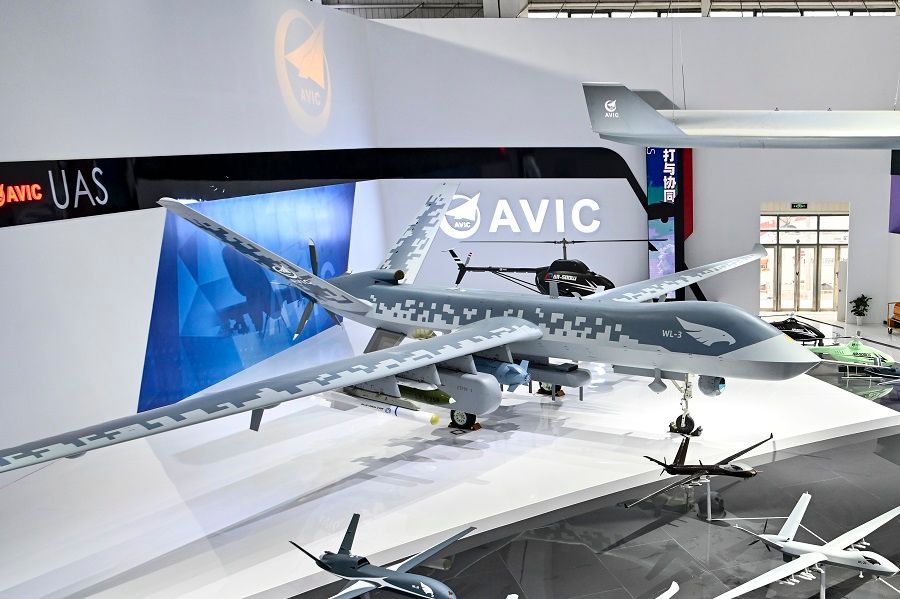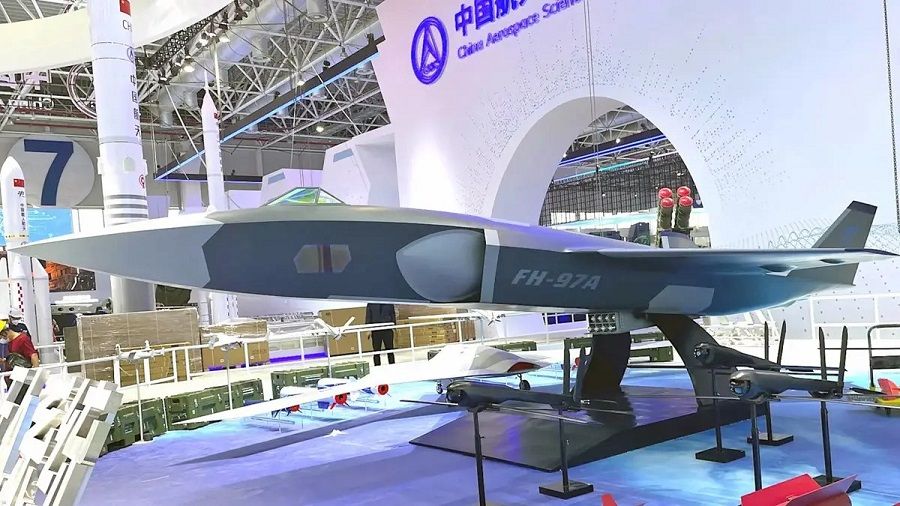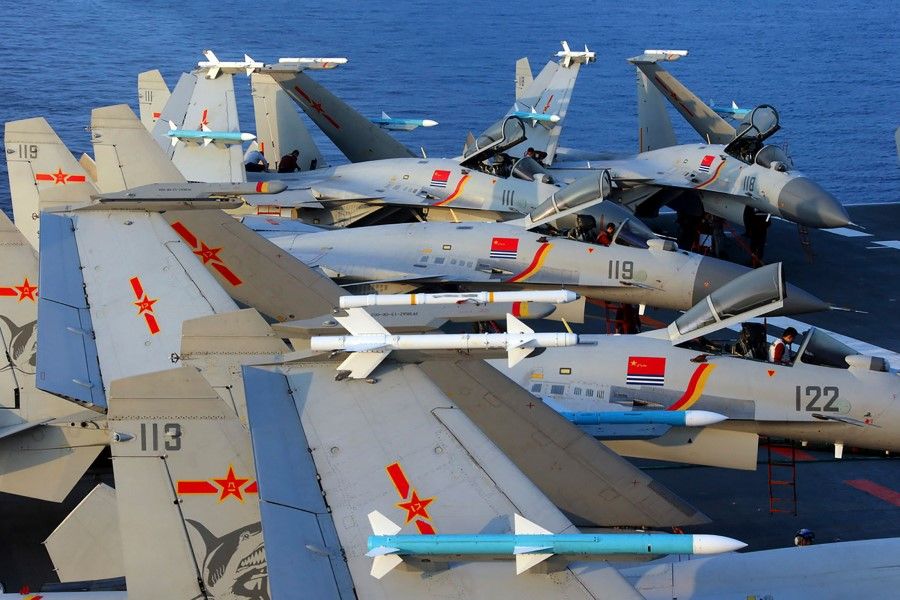China's latest military drones on display at Zhuhai Airshow

At the 14th China International Aviation and Aerospace Exhibition (Airshow China) in Zhuhai from 8-13 November, Chinese-designed unmanned aerial vehicles (UAVs) such as the Wing Loong-3 (WL-3), Feihong-97A (FH-97A) and Caihong-7 (CH-7), as well as the 20-series aircraft of the Chinese People's Liberation Army Air Force (PLAAF) will be on display.
In recent years, UAVs or military drones have become a new "weapon of mass destruction" that could change battlefield dynamics due to their performance in military conflicts worldwide, as evidenced in the Russia-Ukraine war. Hence, the Chinese military has placed great importance on the development of UAVs, with the WL-3, FH-97A and CH-7 seen as "the big three" of this year's airshow.
Air combat-ready UAVs
The WL-3 is China's latest UAV capable of conducting reconnaissance and attack missions. Compared with its predecessor WL-2, the WL-3 is bigger, can fly a longer distance, and has a greater payload capacity and a higher combat power. Among other medium-altitude, long-endurance unmanned aerial systems of the same tonnage class, the WL-3 is an advanced world-class drone.
According to Chinese military experts, the WL-3 has a maximum takeoff weight of 6,200 kg, a flight autonomy of 40 hours and a flight range of 10,000 km - it is basically an "intercontinental" UAV.

The WL-3 displayed at the airshow is fitted with the PL-10E short-range, infrared-homing missile, China's most advanced short-range air-to-air missile, which the US's Military Watch magazine described as one of the world's most dangerous short-range air-to-air missiles. The fact that the WL-3 is displayed carrying this missile shows that the UAV already has air combat capabilities, which is relatively rare among other similar drones in the world.
The WL-3 is also able to carry up to nine weapons, with four hardpoints under each wing and one under the fuselage, outnumbering even some manned fighter aircraft. It is able to carry various precision-guided munitions, air-to-surface missiles, and submunition dispersers.
UAV capable of supporting fighter jets
The FH-97A is seen as a "loyal wingman" of the J-20 stealth fighter aircraft, the backbone of the PLAAF. It is a high-speed stealth drone with an Electro-Optical Distributed Aperture System and an embedded intelligent skin antenna of the same class as the J-20. This equips the FH-97A with the same type of speed and stealth capabilities as conventional fifth-generation fighter aircraft, and allows it to operate alongside the J-20 in joint combat missions.

The FH-97A also has a large weapon bay that can carry eight missiles or loitering munition, effectively compensating for the J-20's lack of ammunition. The FH-97A is also a heavy-duty surveillance drone in its own right, with excellent cruise capability and commendable air combat capability. It can also be used as a drone carrier, releasing and directing smaller UAVs for swarm operations.
The aerodynamic shape of the CH-7 is similar to the US military's X-47B. It has a maximum take-off weight of 13 tonnes, the highest in the CH drone series. It is fitted with active-phased array radar, with various modes for air and land functions where it can carry out reconnaissance and attack missions. Like other fifth-generation stealth fighters, the CH-7 has an ammunition hold for all its armaments - it can conduct solo missions or work in tandem with the J-20 as a "loyal wingman".
The CH-7 can also be launched from vessels. If loaded on carriers such as the Liaoning, Shandong or Fujian, the CH-7 can work together with the J-15 carrier-based fighter jet. The J-15 could carry out missions that require stealth capabilities by remotely operating the CH-7 on various combat operations, significantly boosting the combat capabilities of China's carriers.

On 6 November, PLAAF spokesperson Senior Colonel Shen Jinke told the media that about 50 types of weapons and equipment will be displayed at the airshow, while seven aircraft models, including the J-20, YY-20 and GJ-2 UAVs, will make their first public flights, to showcase China's progress in building a modernised strategic air force.
... the Zhuhai airshow is a rare opportunity for people to take a look at China's military strength and industry, from equipment, to trading models and specialised equipment for sale.
Public display of military and industry strength
Unlike previous airshows with only aerial demonstrations, the J-20 is also on static display at the Zhuhai airshow, the first time the public can get up close to the aircraft.
Two J-20s are already on display, with images taken by military aficionados revealing that they are number 69 and 70 from the third batch of aircraft manufactured in Chengdu. One obvious feature of this batch is the switch to the sawtooth-shaped exhaust of the China-made WS-10C turbofan engine, indicating that the J-20 is completely made in China, which is a boost to the country's production. Military experts estimate that nearly 200 J-20s are in service, and their numbers might be comparable to the total number of fifth-generation fighters in other Indo-Pacific countries.

Also, the brand-new WL-1E UAV will make its debut and conduct an aerial demonstration at the Zhuhai airshow. It had its first flight on 18 January; soon after, it completed standard and high-altitude test flights, as well as payload tests. Chief designer Tang Yong said that the WL-1E will showcase its manoeuvrability and stability during the aerial display, carrying nine air-to-air and air-to-surface missiles.
On 6 November, Guancha.cn ran an article saying that given how the Chinese military keeps its weapons and equipment strictly under wraps, the Zhuhai airshow is a rare opportunity for people to take a look at China's military strength and industry, from equipment, to trading models and specialised equipment for sale.
Amid the global uncertainty of 2022, the equipment and products at the Zhuhai airshow demonstrate the influence of actual war on international military trade, and show the assessment and preparedness of China's military and military sector when it comes to future combat.
This article was first published in Lianhe Zaobao as "珠海航展的亮眼"杀器"".
